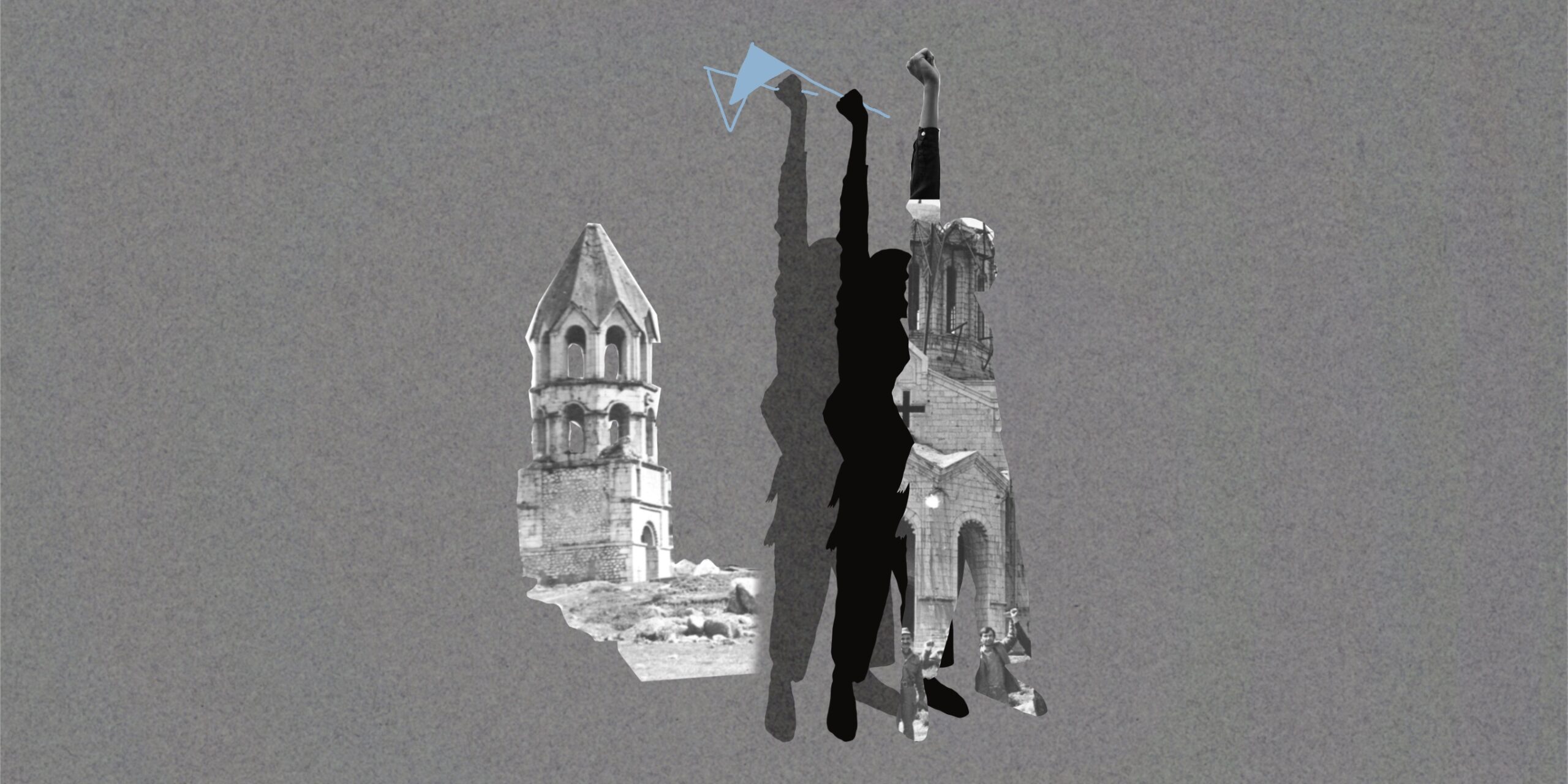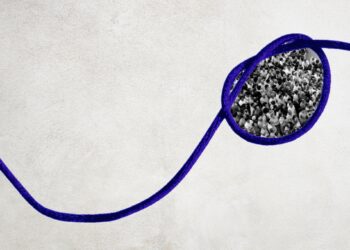
Illustration by Armine Shahbazyan.
May 8 and 9 are important red letter days on Artsakh’s calendar. In addition to Victory in Europe Day (1945), they also mark the anniversaries of the liberation of Shushi and establishment of the Artsakh Defense Army in 1992. With Shushi now inaccessible to ethnic Armenians and its cultural heritage being targeted by Azerbaijan, one would be excused to think the holiday would lose its sheen. However, visiting in person, witnessing the resolve of Artsakh’s people to continue to celebrate life is a breath of fresh air.
While protesters continue to march through Yerevan and other cities in the Republic of Armenia, Stepanakert is characterized by a surprising serenity. One would expect demonstrators to organize in Artsakh to express their views on the Armenian government’s acceptance of a “lowered benchmark” with regard to their status; instead, social stability has been prioritized above all else, with major political figures presenting a unified voice to speak for the people through official statements. There are also cases where war veterans have traveled to Yerevan to protest in person there.
The resilience to persevere through unspeakable trauma was embodied by the tenacity to celebrate the May 8 and 9 holidays with a full schedule of events: an outdoor festival, a STEM Expo in Martakert, and a series of public concerts, including at the newly-opened Paul Eluard Francophone Center in Stepanakert.
The Artsakh STEM Expo in Martakert was organized by the Artsakh Young Minds association to pique the interest of boys and girls in science and technology, encourage new school programs, and share career opportunities.
The Tufenkian Foundation, which has been operating in Artsakh since 2003, also took part in the activities. Rupen Janbazian, their director of Public Relations says that the organization is well aware of the importance of rebuilding and revitalizing Artsakh. After consultations with Artsakh authorities, it has adopted the Martuni region as its focal point for the restoration of houses damaged during the 2020 Artsakh War (especially those belonging to the families of fallen and wounded soldiers), the renovation of schools and community recreational spaces, the equipping of classrooms, first aid and trauma training, and small economic development projects.
Recently, the Tufenkian Foundation launched its “Bringing the World to Artsakh” initiative to help maintain the contact between Artsakh and the world beyond the Lachin Corridor. The program kicked off on the weekend of May 7-8, with performances by singer-songwriter Apo Sahagian in Martuni and Stepanakert. “With this project, we are showing the people of Artsakh that both Armenia and the diaspora stand by their side. For years, we gained strength from Artsakh; now more than ever, it is time for Armenia and the diaspora to be a source of strength for the people of Artsakh. At the same time, we intend to show all Armenians that they can come to Artsakh, visit this part of the homeland, and even launch their own initiatives, despite the fact that the situation has changed and is difficult,” says Janbazian, adding that some people are surprised that he travels to and from Artsakh for work. “There is a lot of fear in people and that leads to indecision and hesitancy. They don’t realize that they too can come and engage with Artsakh. We try to break through these views through our programs. We can’t let the people of Artsakh be cut off from the rest of the world.”
Singer Apo Sahagian is from Jerusalem. During the 2020 Artsakh War, he collaborated with the Armenian Ministry of Foreign Affairs to facilitate access to the conflict zone for international journalists. He says he had always wanted to give a concert here. He added a few songs in the Artsakh dialect and the crowd loved it.
For Sahagian as well, the concerts carry a symbolism that was ingrained in him as he grew up. “When a terrorist attack happens, after a few days, the people celebrate life and make a point that they are still there. I think that’s one way to resist, through culture. While Azerbaijanis seek our death, we show life,” says the singer-songwriter. He is happy to be in Artsakh, to breathe its air and take in its beauty; he thinks it’s important for all Armenians not to take it for granted and plan their next visit. “There may be Azerbaijani troops on the hilltops, but there is still life here. The people are committed to Artsakh; we must be, too,” he explains.
The Resistance in Aghavno
Just across the border from the Republic of Armenia is a kind of quasi-enclave surrounded by territories occupied by Azerbaijan and under the supervision of Russian peacekeepers. The town of Aghavno is still breathing. There are whispers in this picturesque village of reddish tiles that Azerbaijan might take control over the entire Lachin Corridor. Nevertheless, the inhabitants assure us that they will never leave their homes. Cultural and educational activities and celebrations continue, as a confident challenge against the rumors.
On the triple celebration of May 9, the residents gathered in the small church of the village, located high up and attached to one of the military posts of the Russian peacekeepers. Adults and children paid homage to the fallen heroes by laying a wreath on the khachkar (cross-stone) and monuments dedicated to the soldiers killed in World War II and the First Nagorno-Karabakh War.
Sahagian also attended and followed the ceremony with a dedicated performance in the auditorium of the village’s school, which was recently renovated with the financial support of diasporan donors. This space will also welcome a theatrical group next week.
Regarding the complexity of Aghavno’s situation, town mayor Andranik Chavushyan is adamant that he will not leave the town. “We need a homeland for the next generation to have their place,” he says. Many of his neighbors feel the same.
Chavushyan is actively involved in promoting the development of the village, from the implementation of educational programs with young leaders who teach English or music classes to children, to the foundation of businesses such as a new co-op bakery and livestock herds.
The well-known Like Our Mountains monument symbolizes how the people of Artsakh are entrenched in their land. The unshakeable nature of their resolve is difficult to describe in words. It is both inspiring and humbling. The people of Artsakh view history from a long-term perspective. It is possible to lose battles, but it’s not possible to lose Artsakh.
Spotlight Karabakh
International Community Must Prevent Azerbaijan’s Creeping Ethnic Cleansing in Nagorno-Karabakh
Latest developments in Nagorno-Karabakh demonstrate Azerbaijan’s intent to ethnically cleanse the indigenous Armenian population and highlight the necessity of introducing international norms in the peacekeeping architecture there.
Read moreHow Russia Pushed For—and Achieved—a Military Presence in Artsakh
Over a year after Russian troops were deployed to Artsakh, here’s what we know about the Russian presence there, with the historical background for Moscow’s drive for boots on the ground in Artsakh.
Read moreThe Aftermath
This is not a story about war. This is the story of what happens after the bullets, missiles, bombs and drones no longer fly through the autumn air. Maria Titizian recounts her journey to Artsakh last year, two days after the signing of the trilateral statement ending the war.
Read moreThe Guardian Women of the Front Lines
While the majority of women didn’t pick up guns to fight in the war, many used their skills to fight in their own way. On this first anniversary of the 2020 Artsakh War, Kushane Chobanyan presents the stories of six extraordinary women who were on the front lines.
Read more




